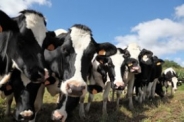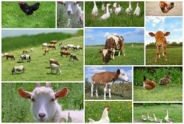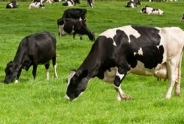Financial Balancing Act Means Managing Risk is Essential
Joan Sinclair Petzen, Farm Business Management
Northwest New York Dairy, Livestock & Field Crops
USDA - Market Facilitation Program (MFP)
There has been a lot of buzz in the agricultural press about the USDA-MFP. The program provides direct payments to help corn, soybean, wheat, dairy, hog and other producers who have been directly impacted by illegal retaliatory tariffs, resulting in the loss of traditional exports. Sign-up for the program is open now through January 15, 2019 at your local Farm Service Agency (FSA) office.
The initial MFP rates for local crops are as follows:
• Corn $0.01 per bushel
• Dairy $0.12 per cwt.
• Hogs $8.00 per head (number of head as of August 1, 2018)
• Soybeans $1.65 per bushel
• Wheat $0.14 per bushel
An initial payment will be made shortly following signup on fifty percent of the producers' production history. For details on the production history for each commodity refer to the MFP Fact Sheet: https://www.fsa.usda.gov/Assets/USDA-FSA-Public/usdafiles/State-Offices/Nebraska/pdfs/MFP%20Fact%20Sheet.pdf. On or about December 3, 2018, CCC will announce a second payment rate, if applicable, that will apply to the remaining 50 percent of the producer's production.
Cornell University's Dr. Andrew Novakovic summarized the process used to determine the payment levels outlined in a USDA press release: https://www.usda.gov/media/press-releases/2018/09/13/usda-details-trade-damage-estimate-calculations as follow, "Secretary Perdue asked his Chief Economist to advise him on how to divvy up the pot. Dr. Johansson and his team decided to use the approach that is used in World Trade Organization trade disputes. The essence of this calculation is to take the difference between what exports might have been in the absence of whatever policy triggered the damage and what exports actually were or are projected to be. This total dollar amount is the total damage. If a compensating payment is made on all milk produced, then the total damage is divided by total production, to come up with a dollar per cwt. compensation payment."
Dairy Revenue Protection (DRP)
DRP, a new revenue protection tool for dairies, was announced in August 2018. Dairy producers will be able to purchase protection against quarterly declines in dairy revenue. The product pricing is flexible to allow producers to choose whether their coverage and indemnities will be based upon Class III and Class IV prices or butterfat and protein percentages. The latter will use the prices of butterfat, protein and other solids to establish the insured milk price.
Coverage level choices will add more flexibility. Producers may choose to insure coverage levels from 70 to 95 percent of their quarterly production. Premium subsidies decline as the coverage level increases according to the following table.
DRP Coverage and Premium Subsidy Percentages

An application for DRP must be made with an authorized crop insurance agent at any time. Coverage begins when you purchase a quarterly coverage endorsement. Multiple quarterly endorsements can be purchased with one policy. Producers can purchase multiple quarterly endorsements for the same quarterly period to customize their coverage further but coverage cannot exceed their total production for the quarter. Coverage purchases are time sensitive. The sales period begins each day when the coverage prices and rates are validated and published on RMA's website by 4:00 PM Central time and ends at 9:00 AM Central time of the following business day.
During the policy year, Livestock Gross Margin - Dairy Insurance and Dairy Revenue Protection can be purchased. However, the policy with the earliest purchase date for any given quarter will be in effect to cover production for that quarter. Producers can participate in the USDA Margin Protection Program in addition to purchasing Dairy Revenue Protection.
Policy details can be found at: https://www.rma.usda.gov/livestock/.
Rainfall Index - Pasture, Rangeland and Forage (RI-PRF)
Since the hay crop is critical to the success of livestock operations, whether it is harvested mechanically or through grazing, a drought can significantly impact any ruminant livestock business. In recent years, we are seeing wider swings in precipitation and frequently yield of forage crops is impacted for part of the season. The (RI-PRF) crop insurance is designed to provide a cash payment to allow producers to cover a shortfall in forage production during a drought. This policy must be purchase by November 15 of year preceding the crop production season.
RI-PRF is an area-based plan of insurance that uses a rainfall index to determine losses and trigger indemnities. It is important for ranchers and farmers to understand that payments are not based on individual rain gauges on their farm or a single weather station. This policy is designed to insure against a decline in an index value that is based on the long-term, historical, average precipitation for the same area of land for the same period of time. It does not measure, capture, or use the actual crop production of any producer or any of the actual crop production within the area.
Indemnity payments are earned by policy holders when the Final Grid Index is less than the result of multiplying the Expected Grid Index by the coverage level selected by the producer, which is referred to as the Trigger Grid Index. RI-PRF only covers a decline in the precipitation index. It does not cover other perils such as, but not limited to, flood, fire, and hail. NOAA CPC data is used to calculate the Final Grid Index and the Expected Grid Index.
Because RI-PRF is an area insurance plan and does not measure, capture, or use any actual crop production, an eligible producer may experience a production loss and not receive an indemnity payment. However, it is also possible for an eligible producer to receive an indemnity payment without suffering a loss of actual production. The producer's amount of production is not considered and no on-the-ground inspection of crop conditions is conducted to determine eligibility for an indemnity payment.
Online tools are available to assist producers to determine how well the program correlated with their past forage production on the RMA https://prodwebnlb.rma.usda.gov/apps/prf. It would be instructive to plug your farm location into the tool and get an idea of what the historical indemnities might have been.
Remember the goal of crop insurance is to take the "bumps in the road" out of your cash flow from year-to-year. Each of these programs and insurance policies offer producers a chance to choose a coverage option to protect against revenue loss from price changes or weather events. If your business is not in a position to mitigate these risks on its own, then reach out to your advisors, or engage in a conversation with a crop insurance agent to learn how reduce your risk through program participation or insurance.
USDA RMA fact sheets and tools were used to source information for this article.
Financial Balancing Act Means Managing Risk is Essential (pdf; 575KB)
Upcoming Events
2026 Corn Congress
January 14, 2026
Henrietta, NY
Participant Registration for the 2026 Corn Congress NOW OPEN!
NOW OFFERING 1.5 DEC Recertification CREDITS
2026 Forage Congress
January 28, 2026
Nunda, NY
Vendor Registration 12.08.25





